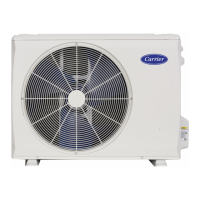38MBRC: Service Manual
Manufacturer reserves the right to change, at any time, specifications and designs without notice and without obligations.
15
TROUBLESHOOTING
This section provides the required flow charts to troubleshoot problems
that may arise.
NOTE: Information required in the diagnoses can be found in
the wiring diagrams.
Required Tools:
The following tools are needed when diagnosing the units:
• Digital multimeter
• Screw drivers (Phillips and straight head)
• Needle-nose pliers
• Refrigeration gauges
Recommended Steps
1. Refer to the diagnostic hierarchy charts below and determine the
problem at hand.
2. Go to the chart listed in the diagnostic hierarchy and follow the steps in
the chart for the selected problem.
For the ease of service, the systems are equipped with diagnostic code
display LED's on both the indoor and outdoor units. The outdoor
diagnostic display is on the outdoor unit board and is limited to very few
errors. The indoor diagnostic display is a combination of flashing LED's
on the display panel on the front of the unit. If possible always check the
diagnostic codes displayed on the indoor unit first.
The diagnostic codes for the indoor and outdoor units are listed in the
following pages.
Problems may occur that are not covered by a diagnostic code, but are
covered by the diagnostic flow charts. These problems are typical air
conditioning mechanical or electrical issues that can be corrected using
standard air conditioning repair techniques.
For problems requiring measurements at the control boards, note the
following:
1. Always disconnect the main power.
2. When possible check the outdoor board first.
3. Start by removing the outdoor unit top cover.
4. Reconnect the main power
5. Probe the outdoor board inputs and outputs with a digital multi-meter
referring to the wiring diagrams.
6. Connect the red probe to hot signal and the black probe to the ground or
negative.
7. Note that some of the DC voltage signals are pulsating voltages for
signal. this pulse should be rapidly moving at all times when there is a
signal present.
8. If it is necessary to check the indoor unit board you must start by
disconnecting the main power.
9. Next remove the front cover of the unit and then control box cover.
10. Carefully remove the indoor board from the control box, place it face
up on a plastic surface (not metal).
11. Reconnect the main power and repeat steps 5, 6, and 7.
12. Disconnect main power before reinstalling board to avoid shock hazard
and board damage.

